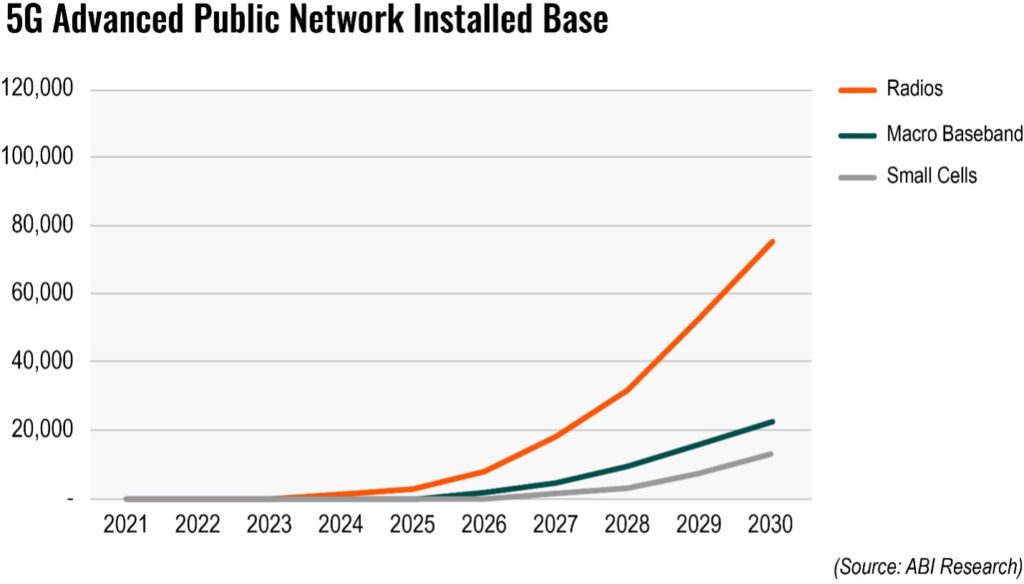5G Advanced, or as some vendors call it, 5.5G, is the next iteration of cellular standards and promises to enhance current 5G networks with not just organic updates, but also introduce major new functionality primarily targeting enterprise networking. These new features include Sidelink, Reduced Capability (RedCap) and advanced positioning. 5G Advanced will be specified by The 3rd Generation Partnership Project (3GPP) Releases 18, 19 and 20, after which 3GPP’s work will focus on 6G, which will likely be built on the foundations that 5G and 5G Advanced have set.
5G Advanced is important because it will implement learnings from the deployment of early 5G networks, in the same manner that 3.5G did with High-Speed Packet Access (HSPA) and Long-Term Evolution (LTE)-Advanced with Carrier Aggregation (CA). 5G Advanced will likely become the mobile network powerhouse for many years to come, until 6G takes over and builds on the foundation of 5G Advanced and 5G. Some of the improvements it will introduce are in new directions, particularly in the enterprise domain, meaning that the companies that will benefit the most from the new generation may not be from the established value chain.
5G positioning, RedCap and Sidelink are presenting new ways of connecting devices and utilizing the network, which may lead to new use cases and applications, and will likely create new ecosystems. Indeed, according to ABI Research forecasts, 5G Advanced will start to proliferate in 2025, when advanced use cases and applications will start to enter the mainstream. The following chart illustrates 5G Advanced infrastructure forecasts from ABI Research’s latest reports.

5G Advanced for enterprise applications
5G Advanced will introduce new radical features that aim to introduce significant value for enterprise applications. These include positioning improvements that aim to ultimately reach <1 Centimeter (cm) accuracy in the future; Sidelink, which will allow a much more flexible deployment approach for on-premises deployments; and RedCap, a more efficient terminal for IoT applications.
5G positioning promises to address most of the Real-Time Location Services (RTLS) use cases by tapping into pre-deployed 5G infrastructure used for communications, rather than deploying numerous RTLS solutions (e.g., Ultra-Wideband (UWB, Bluetooth Low Energy (BLE), Wi-Fi, etc.) that are often use case-specific and require heterogeneous equipment (e.g., tags, anchor points and gateways). This can help drive down the cost and complexity of location services, and enable much more scalable deployments of positioning use cases over the next decade.
RedCap devices are central to the creation of mobile services with the user positioned firmly in the middle surrounded by multiple devices that act as enablers, whether that device is a smartphone or tablet, automotive, set of wireless earbuds, or a smartwatch. An experience-centric design moves devices to function as hubs that can support multiple devices, so a system-level design needs to support and expand beyond just the main hubs to address all device types. It is important that the industry focuses on the enablement of these 5G Advanced use cases and experiences to embrace the wider implications of moving the market from a device-centric to an experience-centric ecosystem.
Bringing 5G Advanced to the market
5G Advanced is an important milestone to prepare the industry for 6G, which will focus on distributed intelligence, the blending of physical and virtual worlds, and the full use of Artificial Intelligence (AI)/Machine Learning (ML) throughout the network. Several infrastructure vendors are now preparing the next wave of innovation in this domain, including Ericsson, Huawei and Nokia, which are starting to promote 5G Advanced. Huawei held its latest innovation event in July 2022 (Win-Win) and has named the technology “5.5G” as an interim step toward 6G. In this framework, Huawei is tackling industry-wide trends that all vendors will promote in the next few years. Specifically, Huawei’s 5.5G strategy includes the following:
- 10 Gigabits per Second (Gbps) experience for all users, including a variety of technologies— not just cellular. Huawei claims that this target will need Fiber to the Room (FTTR), Wi-Fi 7 and other connectivity technologies.
- Reaching beyond simple connectivity, allowing telcos to monetize their network assets in the enterprise domain.
- Distributed computing and advanced storage.
- AI throughout the network with higher orders of autonomous operation.
- Green operation for the network.
It remains to be seen how Huawei will implement these features, but 5G Advanced is indeed an opportunity for telcos to monetize their capabilities beyond the consumer domain. If they manage to do so, even on a very basic scale, they will be able to position themselves as key stakeholders for 6G.

